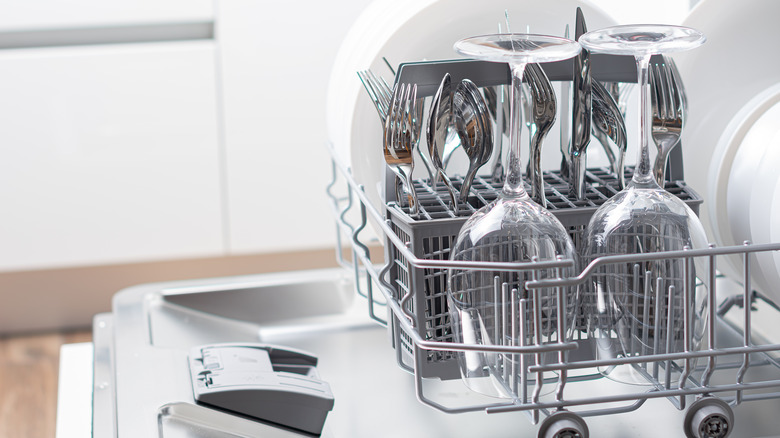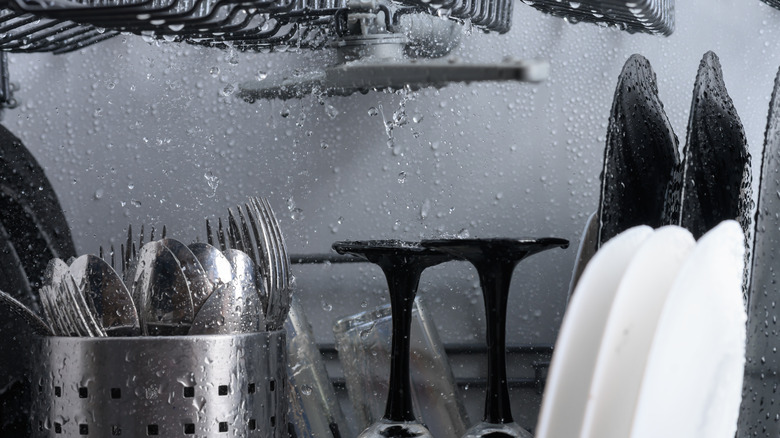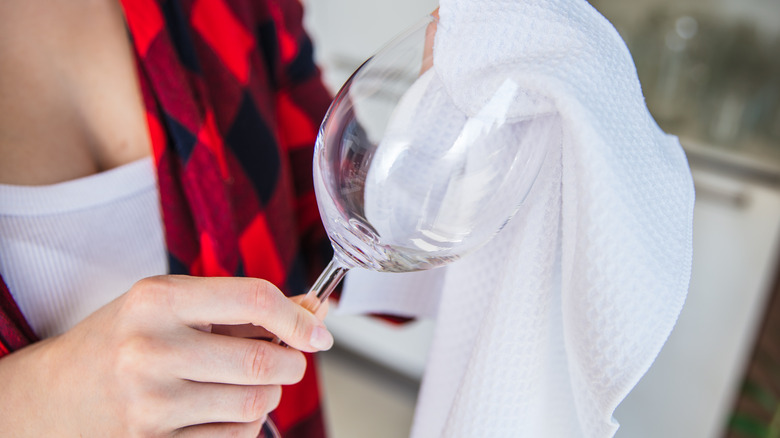Here's Why You Should Never Place Wine Glasses In The Dishwasher's Bottom Rack
The majority (75%) of adults genuinely enjoy a glass of wine every now and then, and nearly half drink at least two glasses per week (via Survey Monkey). But there's one aspect of drinking wine that isn't so relaxing: Piles of dirty wine glasses. Sometimes glasses stack up on the counter after a few days, or you have several friends over for a dinner party, and next thing you know, you're elbows deep in dish soap. Luckily, your dishwasher is here to save the day, but if you've been nonchalantly tossing wine glasses onto the dishwasher racks, you may want to reconsider your placement. Setting wine glasses in the bottom rack could make the wash cycle ineffective and even prevent your other dishes from getting clean.
Dishwashers are specifically designed to clean cups and glassware on the top rack and larger cookware, dishes, and flatware on the bottom rack. Placing your wine glasses on the bottom rack won't get them as clean, and it could even have some dangerous consequences. Learn more about how you should take care of your glassware and properly load your dishwasher.
Risks of bottom rack washing
Most dishwashers have two spinning spray nozzles that rainwater down onto the bottom rack and up into the top rack. The shape of the upper rack and its spinner are intended to reach up into deep cups, mugs, and glasses. Meanwhile, the bottom rack is best for cleaning flat surfaces like pans and plates. Putting glasses on the bottom rack could prevent the water from reaching up inside the wine glass, so it won't be cleaned as effectively as it would up top. Additionally, the bottom rack is designed to hold plates a certain distance apart, and wine glasses can throw a wrench in the equation.
Another important reason to keep your wine glasses on the top rack is that the delicate glassware could easily crack or break. Depending on the material, most wine glasses can be washed in the dishwasher (fine crystal is an exception to this). However, wine glasses should always go on the top rack because the temperature is slightly lower, keeping the glassware from cracking due to heat. The top sprayer also usually has less water pressure because it isn't intended for blasting away baked-on gunk. High water pressure could cause the glasses to knock around, chip, or fall over. This is a big safety hazard when you go to unload the dishwasher, and in a worst-case scenario, shattered glass could even end up in your dishwasher's drain basket, damaging the appliance and potentially flooding your kitchen.
The best way to wash wineglasses
After a busy dinner party or long weekend, it's perfectly fine to toss your wine glasses in the dishwasher; just make sure you're doing it in a way that's safe and effective. Always wash glassware on the top rack, and place the glasses upside down with plenty of wiggle room between them. Some dishwashers even come equipped with wine stem holders to keep glasses from clanking together. Use a delicate, low-heat wash cycle, and be sure to turn off the heated dry function to avoid damaging the glass.
Of course, hand washing is a great alternative for wine glasses and other delicate glassware. To clean your glasses by hand, soak away any dried wine with warm water and dish soap. Unscented soap is preferable to avoid distorting the next glass of wine with any lingering scent. Wash each glass with a gentle cloth or your bare hands and rinse thoroughly to clear any remaining soap. It's also wise to hold the stem of the wineglass while cleaning, as Kristin Olzewski, wine director at Gigi's in Los Angeles and cofounder of Nomadica, told Wine Enthusiast, "Holding the base can result in breakage, and I've seen some really insane restaurant accidents involving broken stems." When finished washing, air dry upside down on a drying rack and use a microfiber cloth to polish away spots.


